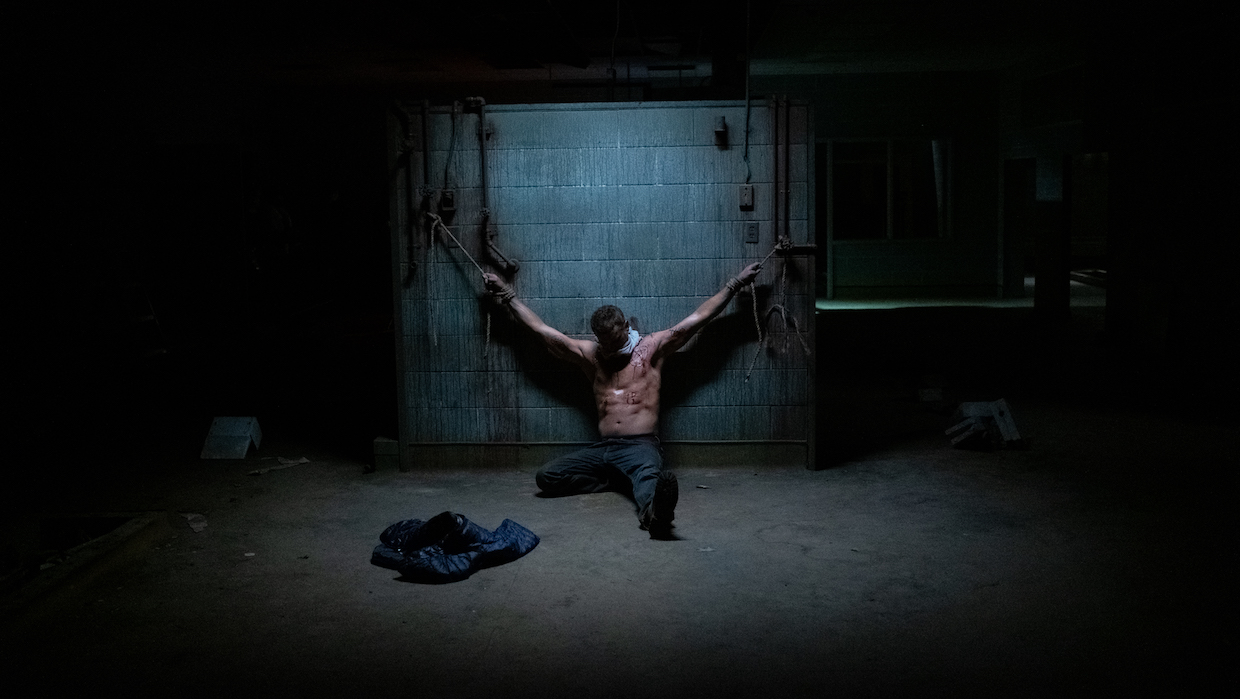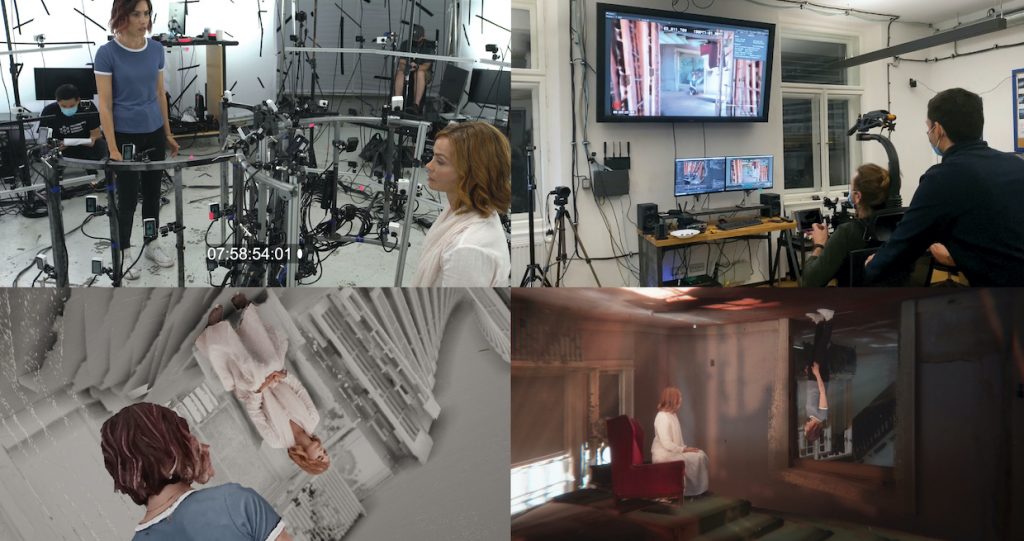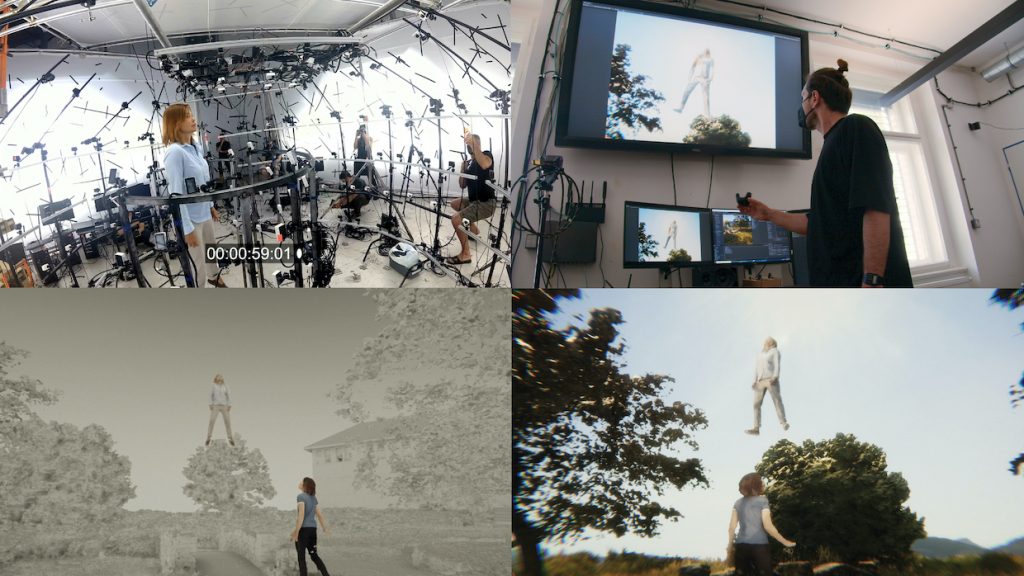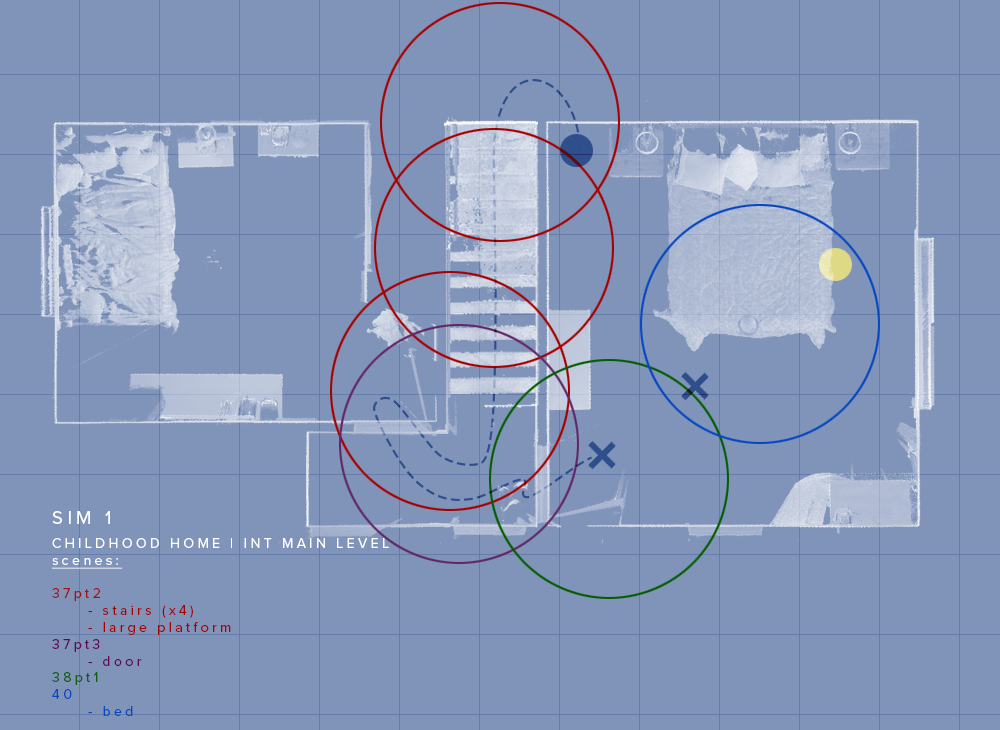 Back to selection
Back to selection
Shutter Angles
Conversations with DPs, directors and below-the-line crew by Matt Mulcahey
“15 Terabytes of Data Per Day”: Neill Blomkamp on Making Demonic with Volumetric Capture Technology
 Demonic
Demonic I’ve always had an affinity for tales of Roger Corman’s frugal resourcefulness. If the legendary filmmaker had a standing set and a “name” actor with a few surplus days left on a contract, you can bet Corman was going to expediently craft a movie to fit those puzzle pieces.
Outside of a shared fondness for social commentary within genre, the films of Oscar nominated writer/director Neill Blomkamp (District 9, Elysium)—with their cutting-edge special effects and ample budgets – don’t typically bear much resemblance to Corman’s drive-in heyday. However, Blomkamp’s latest effort, Demonic, was constructed with a similarly enterprising spirit.
When the pandemic halted most production last year and shelved Blomkamp’s latest project, he quickly penned a new script, rounded up a team of frequent collaborators, and set about making a small scale, low budget horror film shot almost entirely within a short drive of his home in British Columbia. The movie also allowed Blomkamp to experiment with new tech, using volumetric capture for scenes where his protagonist (played by Carly Pope) uses a computer simulation to enter the subconscious of her comatose mother, where the titular entity also lurks.
Demonic is in theaters and available on VOD starting tomorrow. (https://www.demonicmovie.com/)
Filmmaker: When things began shutting down last year, were you close to being in production on any projects?
Blomkamp: I had just come back from location scouting in Albuquerque, New Mexico for a movie called Inferno. So I had been back in Vancouver for like a month and then everything started to close down. It became evident that any traditional film in the Hollywood system was offline for at least six months if not longer. For the last decade I had been interested in shooting a small, self-financed horror film just to sort of challenge myself with that. I love the idea of what the filmmakers did in Paranormal Activity and Blair Witch. It seemed like the perfect time to do it. I had also been interested in using volumetric capture technology. So, I merged that with this idea of making a low budget horror film and it blossomed from there.
Filmmaker: When you’d been thinking about making a small-scale horror film over the years, did you have a story already developed? Or was Demonic written specifically to fit the set of parameters you were going to be working within?
Blomkamp: It was like the reverse of the normal process. Typically, you would write a screenplay and then you would go, “Okay, how do we execute it?” This was totally backwards. It was like, “What do we have access to?”
Filmmaker: How long roughly from first draft to the first day on the set?
Blomkamp: Maybe three to four months.
Filmmaker: That’s quick. In that time you’ve also got to cast, you’ve got to find locations, you’ve got to make props, maybe build sets.
Blomkamp: I think the only thing we didn’t do was build sets. We dressed a lot of existing locations, but they were real locations. I don’t think we had the money to build anything.
Filmmaker: Even when you’re just dressing the sets, the art department still has a lot of elements to create. There’s a scene where a character has a shipping container full of demon sketches. Somebody has to draw all of those.
Blomkamp: Yeah, totally. That was all art department. The art department worked around the clock and we also had to build the suit for the creature. It was pretty intense.
Filmmaker: The creature has a very unique avian design. Where did that come from?
Blomkamp: Yeah, I love the design of the demon so much. I’m not sure exactly where it came from. Because of the pandemic I was looking up those plague masks from the middle ages and I think maybe I was riffing on that and it turned into a beak. Once I started thinking about a seven-foot bipedal raven, I was really into that. So I sent that idea to this awesome concept artist that I use, her name is Eve Ventrue, and she drew this insanely perfect image. I think it’s the only thing I’ve ever worked on that there was just one image. She just drew it and that was the creature. Then Werner Pretorius and his company, which is called Amazing Ape, built a seven-foot creature out of it. It has an animatronic beak on it that’s almost a meter long, so it has a real 1980s horror movie vibe to it that I love.
Filmmaker: So you did the traditional part of the shoot first, right, then you did the volumetric capture?
Blomkamp: Yeah. I think we shot 19 days of traditional photography, then shut down for like a month because we had to build the volumetric capture rig in Vancouver, then we shot that for four days.
Filmmaker: When you were shooting, were the Canadian borders even open? Did you have to essentially use all Canadians for the crew?
Blomkamp: Yeah, I don’t think there were any Americans unless they were already in Canada. Actually, I initially wanted to use this company Metastage in L.A. [for the volumetric capture]. I had been speaking to them about vol cap in general for two years because I loved the technology. Then finally I came up with a project to use vol cap for, the border closed and I couldn’t use them. That’s how we found Volumetric Camera Systems in Vancouver. I think Carly did come from the U.S. prior to the border fully closing and she just had to quarantine, then I think the border shut. She’s Canadian, but she lives in L.A. But, generally speaking, it was all people who were already here who we had worked with before. It was a really tight-knit group and we just went out and shot it.
Filmmaker: Walk me through some of the details of shooting in this volumetric capture setup. So, basically, you have a dome-shaped rig with 250 cameras sort of equidistant from the center, then you can take that footage of the actor and place them into any environment.
Blomkamp: Basically, yeah. The process is essentially a video version of photogrammetry. Photogrammetry would be turning a real-life object into a three-dimensional virtual object. So, if you put a shoe in the middle of that environment with 250 cameras and snap the shoe from all angles, the computer would extrapolate a CAD [computer-aided design] model of the shoe and it would look pretty real. This process, volumetric capture, is like that, but in video form, 24 times a second. Your actors are in a volume, but it’s not really designed for motion. So, if an actor walks four meters across a room, they’re actually going [all the way from one side of the rig to the other] and so you get a resolution drop-off—like their back will have no coverage [on one side of the rig] and then eventually their face will have no coverage [on the other side]. So, as they move they’ll kind of go in and out of areas of high resolution. Then when you have two actors in there it’s even more complicated. It was a nightmare to shoot and it’s a nightmare to manage the amount of data as well, because 250 cameras times 4K resolution times 30 or 40 minutes of shooting is like 15 terabytes of data per day.

Filmmaker: I wondered whether you shot the mother and daughter separately for scenes that they are in together. I figured if they were both in the capture rig at the same time, they would block a bank of the cameras from recording the other actor.
Blomkamp: But performance wise, you can’t [shoot them separately]. So, we had to find a way to make sure that they were in there at the same time. What we did was build these smaller, scaffolding-like cylinders that would be the width of an oil drum. The inside of that surface would be caked with maybe 40 or 50 small cameras. We could wheel that close to one actor, then wheel another one close to the other actor. [These cylindrical rigs can be seen next to the actors in the upper left image above.] So, now they’re both in the same volume, but they also have these cage rigs around them. They have to deliver emotional performances through all of that, which was difficult for me so it had to be difficult for them too, but they’re so good that they got through it.
Filmmaker: Tell me more about how you handle movement. If the actor is moving, wouldn’t all those cameras have to adjust focus?
Blomkamp: Everything is on autofocus. They’re pretty intelligent small 4K cameras and they are autofocusing based on proximity. If you think about the amount of data, to sort through 250 angles of one thing, like we have absolutely no idea [if one camera is out of focus in a shot], but the computer will make that decision for you. It’s going to extrapolate a 3D object. So, say, frame 17 from 250 cameras is going to be turned into a 3D object, then frame 18 will be turned into a 3D object and then frame 19 [and so on]. So, each frame calculation will be slightly different and that’s why you get this jittery look to [the volumetric capture footage], like the bubbling polygons are shifting because of that.
Filmmaker: Are the cameras you used specifically made for this purpose?
Blomkamp: This process is so new that I think everyone does it differently. They’re all building their own bespoke way of doing it from either industrial or off-the-shelf things. The particular ones we used are I think machine learning cameras, like where you have a robotic arm sorting things on a conveyer belt and it’s doing visual recognition. I think these cameras are used in that application. They’re very high resolution, but they look disgusting if you were to shoot a normal image with it. Your objective in lighting is to eliminate shadows completely. That’s your goal—just diffuse, ambient light. Then you can re-light them however you want [in post]. If you’ve lit the character correctly, you won’t be confused by seeing shadows [from the lighting in the vol cap session[ on the character that shouldn’t be there [based on the lighting sources created in the virtual environment].

Filmmaker: Is the idea that you want a wide focal length and deep focus?
Blomkamp: Actually, what we learned is that we should have used cameras that were further apart on much tighter lenses, but to do that [with the cameras we had] would’ve meant buying 250 adapters and 250 lenses and the cost just gets to a point where you’d have to do an Avengers film to do it properly. So, eventually it was just like, “Let’s just do what we can with what we have.” So, the cameras were a little more GoPro-y and wide angle. There are benefits to that. It’s easier to extrapolate into 3D when the computer looks at it from a wider field of view, but the benefit [of the longer lenses] would’ve been that the actors could’ve moved around more instead of the mind-bending lunacy of the situation that we filmed in.
Filmmaker: When Carly goes up and down stairs in the virtual environments, are you bringing in green stairs into the vol cap rig that can be keyed out to get that movement?
Blomkamp: Yes, but they don’t have to be green though. If you go back to the photogrammetry idea of each frame being a 3D object, say she’s walking up wooden plywood stairs that we built. What you would see when that frame is calculated is a photo-real version of Carly standing on a plywood bunch of stairs in 3D, and you’d also see that hemisphere cage I was talking about that we’d move closer to the actors, because that would also be seen by the other cameras. So, then we had to go in and polygonally select the stuff we didn’t want—like the plywood stairs and the rig—and delete them.

Filmmaker: How did you capture the environments you were going to put these 3D versions of the actors into?
Blomkamp: Carly’s childhood home, for example, that’s a real home that we location scouted like you would for a normal movie. Then we shot 12,000 photos of the house, both inside and walking around the outside and with drones, and we fed all of that info to a piece of software that will turn it into a 3D mesh. Now we have a 3D house that she’s going to be in. So, if the volumetric capture rig is four meters across but the house is 40 meters across with two floors, you have to design a walk path for the actor. What we did was make almost architectural plans [see the photo above], then there’d be circles that would represent the size of our volume. So, the circles would show us how she’d have to walk through the space. For example, you could see which [point along that path] she’d have to make a right turn or go up the stairs. It’s like a math formula.
Filmmaker: What is that sanitarium location in the film?
Blomkamp: It’s in a city called Kamloops. Again, that’s an example of this notion of building the movie out of the pieces we had. Originally, I had written the third act of the movie to take place in this tunnel, which is actually close to where I live. My brother, who runs [our film studio] Oats, was obsessed with that sanitarium back when we were making stuff for Oats. He would always send me videos of that place and say, “We have to shoot here.” So he sent me another video [before we made Demonic] and I looked at it and said, “Holy shit, you’re right. We do have to shoot there.” We went and scouted it and I rewrote the script for that location. Everything else was shot in British Columbia around where I live. That was the only location far enough away where you actually had to stay in a hotel.
Filmmaker: Had you ever used volumetric capture before?
Blomkamp: No, but I wanted to. Pre-pandemic, I probably would’ve used it more in like an Oats Studios YouTube thing where it could’ve been more experimental. But it’s not easy.
Filmmaker: So you said maybe you would’ve put the cameras further away and used tighter lenses. What else did you learn that you’d do differently?
Blomkamp: I think what I learned was to not do it again for a very long period of time (laughs) until maybe the technology is more mature.

Filmmaker: So you’ve done your volumetric capture and you’ve got your 3D actors. You’ve shot your environments to place them into. Once you’ve combined those two elements into whatever software you’re using, tell me about the next step. You’re going in with a virtual camera [seen in the upper right frame above] and basically creating your shots. Is this similar to the tech they used for previs on The Mandalorian, where they would create virtual sets and go in and do like a VR location scout with a virtual camera?
Blomkamp: It is similar. The difference is that what our virtual camera is shooting is in the actual movie that you see. They are creating a proxy rendition of what they would like to achieve later when they shoot it properly, which is like the previs you’re talking about. Or the other version is you’re doing motion capture, something like Avatar, and in your viewfinder instead of seeing Zoe [Saldana] in a bunch of motion capture dots, you’re seeing something that’s more representative of [her character] Neytiri and the Na’vi world. But for our film, those simulations are the final shots. When you look through the virtual camera, it’s exactly what you will see in the movie. The other thing that you can do [with that software] is, you can watch all of those simulation scenes in real, pure VR, where the characters are like 5’ 7” and you’re standing next to them and you can walk around them.
Filmmaker: This process is so foreign to me that I have questions that I almost feel ridiculous asking. Like, say you want to do a dolly shot. Do you have to physically put the virtual camera on a dolly or a Steadicam and move it through space?
Blomkamp: Well, you can do that but a lot of the 3D packages now have dollies or technocranes in the package to make those moves [virtually]. You can simulate it and it will look pretty good. What I wanted to do was, because the live action photography [in Demonic] is so controlled, I wanted everything in the simulation to be totally handheld. It just makes it feel more like you’re standing there [inside the simulation with the characters].
Filmmaker: For a normal shoot, you have some sort of previs plan—maybe it’s a shotlist or storyboards or whatever —ut you have some idea of the pieces that you want to collect on the day and you have a finite amount of time to collect them. When you get into this 3D environment with the virtual camera, how do you avoid being paralyzed by the infinite number of options, where you aren’t really constrained by real-world limitations like the sun going down?
Blomkamp: That’s a real thing, but that part isn’t unique to volumetric capture. You have that in the traditional realm of VFX as well. My own personal style is always to shotlist. I hate storyboards with an absolute passion, but I love shotlists. A shotlist tells you what is required for the cut that you have in your head to work, but it also allows more for interpreting the set when you’re there on the day. So, [when we began using the virtual camera for the volumetric capture scenes] we basically knew what we were going for. When you combine shotlists with a super small budget, you can’t really experiment forever. There has to be a surgical strike mentality with something this low budget.
Matt Mulcahey works as a DIT in the Midwest. He also writes about film on his blog Deep Fried Movies.
